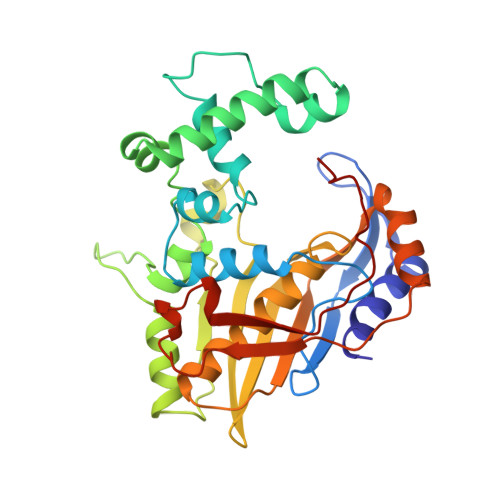Energetic contributions of four arginines to phosphate-binding in thymidylate synthase are more than additive and depend on optimization of "effective charge balance".
Morse, R.J., Kawase, S., Santi, D.V., Finer-Moore, J., Stroud, R.M.(2000) Biochemistry 39: 1011-1020
- PubMed: 10653645
- DOI: https://doi.org/10.1021/bi9918590
- Primary Citation of Related Structures:
1BO7, 1BO8, 1BP0, 1BP6, 1BPJ - PubMed Abstract:
In thymidylate synthase, four conserved arginines provide two hydrogen bonds each to the oxygens of the phosphate group of the substrate, 2'-deoxyuridine-5'-monophosphate. Of these, R23, R178, and R179 are far removed from the site of methyl transfer and contribute to catalysis solely through binding and orientation of ligands. These arginines can be substituted by other residues, while still retaining more than 1% activity of the wild-type enzyme. We compared the kinetics and determined the crystal structures of dUMP complexes of three of the most active, uncharged single mutants of these arginines, R23I, R178T, and R179T, and of double mutants (R23I, R179T) and (R178T, R179T). The dramatically higher K(m) for R178T compared to the other two single mutants arises from the effects of R178 substitution on the orientation of dUMP; 10-15-fold increases in for R23I and R178T reflect the role of these residues in stabilizing the closed conformation of TS in ternary complexes. The free energy for productive dUMP binding, DeltaG(S), increases by at least 1 kcal/mol for each mutant, even when dUMP orientation and mobility in the crystal structure is the same as in wild-type enzyme. Thus, the four arginines do not contribute excess positive charge to the PO(4)(-2) binding site; rather, they ideally complement the charge and geometry of the phosphate moiety. More-than-additive increases in DeltaG(S) seen in the double mutants are consistent with quadratic increases in DeltaG(S) predicted for deviations from ideal electrostatic interactions and may also reflect cooperative binding of the arginines to the phosphate oxygens.
Organizational Affiliation:
Department of Biochemistry and Biophysics, The University of California at San Francisco, San Francisco, California 94143-0448, USA.
















